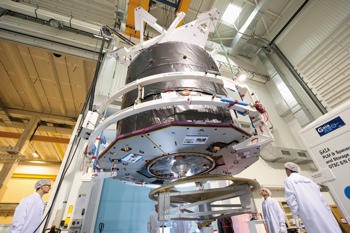
Gaia, the most advanced space telescope ever built in Europe, has left the Toulouse facilities of Astrium, the European leader in space technology, after final integration and testing. Gaia is now en route to its launch site in French Guiana, where it will be prepared for launch aboard Soyuz.
 Designed and built by Astrium for the European Space Agency (ESA), Gaia’s mission is to produce the most detailed map of our galaxy, the Milky Way, and reveal as yet unknown zones. Its goal is to enable us to understand the origins and evolution of the Universe. The Gaia mission is also expected to discover hundreds of thousands of unknown celestial objects, including extra-solar planets and failed stars, known as brown dwarfs. Within our Solar System, Gaia will be able to identify tens of thousands of additional asteroids.
Designed and built by Astrium for the European Space Agency (ESA), Gaia’s mission is to produce the most detailed map of our galaxy, the Milky Way, and reveal as yet unknown zones. Its goal is to enable us to understand the origins and evolution of the Universe. The Gaia mission is also expected to discover hundreds of thousands of unknown celestial objects, including extra-solar planets and failed stars, known as brown dwarfs. Within our Solar System, Gaia will be able to identify tens of thousands of additional asteroids.
Gaia will carry ultra-modern instruments, including the most sensitive telescope ever made. Like the space telescope carried by Herschel, as well as all the instruments made by Astrium for Earth observation missions, this cutting edge equipment is the result of unique expertise developed by Astrium in the field of silicon carbide (SiC) telescopes. Astrium and its partner Boostec, the innovative SME, have created a veritable economic sector through their space-industry achievements – a remarkable success story. The SiC produced in the French Midi-Pyrénées region is exported around the world.
Gaia will also use a ‘photographic’ sensor of unprecedented accuracy. The precision of Gaia measurements will be extremely high: from the Moon, it would be able to measure the thumbnail of a person standing on Earth. It has a huge focal plane made up of 106 CCD detectors gathering 1 billion pixels. For its attitude control, the spacecraft will also utilise cold gas propulsion (nitrogen), which will allow it to continuously adjust pointing performance with the required extreme accuracy.
Gaia will be located at one of the five Lagrangian points in the Sun–Earth system, at the L2 point. Lagrangian points are very precise points in the cosmos where a body such as a satellite remains fixed and perfectly stable in space. Located 1.5 million kilometres from Earth, these locations are vital for astronomy observation missions which require high pointing stability.
About Astrium
Astrium is the number one company in Europe for space technologies and the third in the world. It is the only global company that covers the full range of civil and defence space systems, equipment and services.
In 2012, Astrium had a turnover over €5.8 billion and 18,000 employees worldwide.
Its three business units are: Astrium Space Transportation, the European prime contractor for launchers, orbital systems and space exploration; Astrium Satellites, a leading provider of satellite system solutions, including spacecraft, ground segments, payloads and equipments; Astrium Services, the space services partner for critical missions, providing comprehensive fixed and mobile solutions covering secure and commercial satcoms and networks, and bespoke geo-information services, worldwide.
Astrium is a wholly owned subsidiary of EADS, a global leader in aerospace, defence and related services. In 2012, the Group – comprising Airbus, Astrium, Cassidian and Eurocopter – generated revenues of €56.5 billion and employed a workforce of over 140,000.